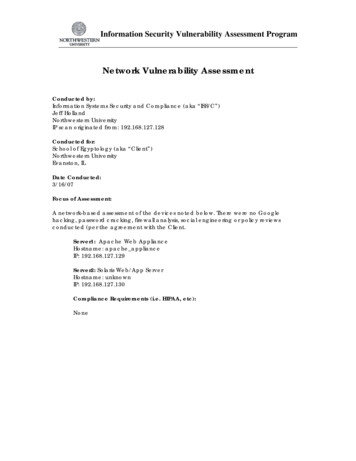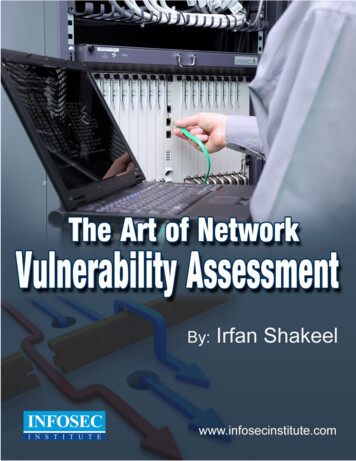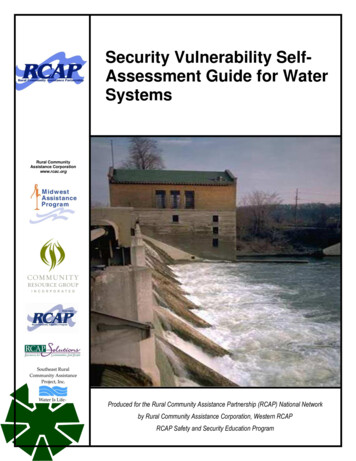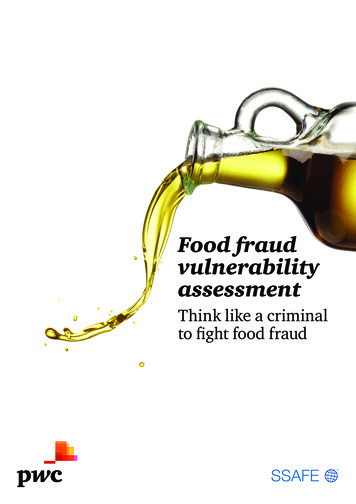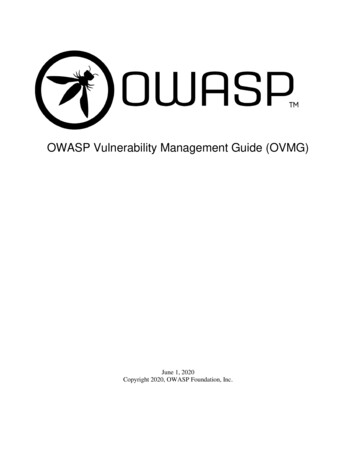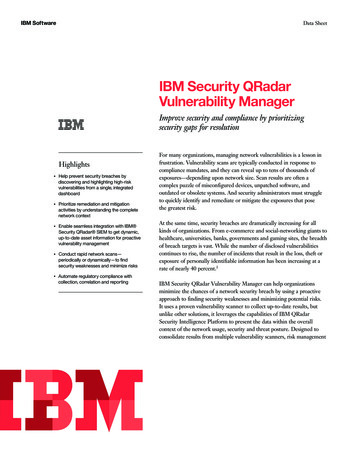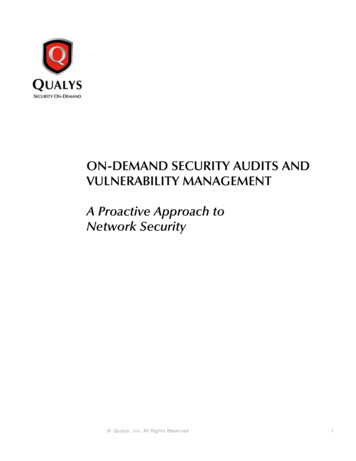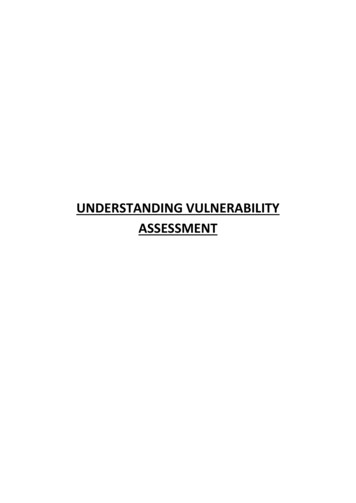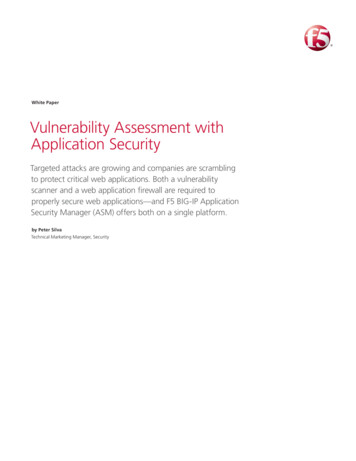
Transcription
Proceedings of the 11th Annual International Conference on Industrial Engineering and Operations ManagementSingapore, March 7-11, 2021A Vulnerability Assessment on the Parental Control MobileApplications’ Security: Status based on the OWASPSecurity RequirementsEric B. Blancaflor, Gerardine Anne J. Anson, Angela Mae V. Encinas, Kiel Cedrick T.Huplo, Mark Anthony V. Marin, Stephany Lhaime G. ZamoraSchool of Information TechnologyMapúa UniversityMakati City, Philippinesebblancaflor@mapua.edu.ph , ua.edu.ph, .edu.ph, slgzamora@mymail.mapua.edu.phAbstractParental control software and hardware are the most common solution for regulating their children’s online activities.Consequently, while this may ease their worries about internet use regulation, it also introduces grave security andprivacy threats. This study was able to analyze the underlying vulnerabilities present in commonly used parentalcontrol mobile applications by parents and propose recommendations from the identified vulnerabilities. Thisquantitative research case study used a vulnerability assessment method utilizing the Quixxi Security tool to yield adescriptive analysis of the results. FamilyTime, FamilyLink, and OurPact are the identified commonly used parentalcontrol application, and they have ten vulnerabilities common with each other.KeywordsCybersecurity, Vulnerability Assessment, Parental Mobile Application, OWASP, MASVS1. IntroductionMinors are constantly being exposed to different dangers with navigating the internet unsupervised, they use theinternet as their means to express themselves completely unaware that the mobile applications that they are using areleaving them vulnerable to attackers. Due to the children’s exposure to the Internet, there is a higher possibility thatthey would encounter brutality, corrupt practices, or exploitation (Council of Europe [CoE], n.d). Ellis (2020) listedthe best free parental control software applications there is in the market that promotes child safety when browsingthe internet, which also allows their parents to not worry about them encountering inappropriate content. Accordingto published research on children protection on the internet by Denić et. al (2017), ten percent of its respondents, whoare parents, used software to control their children’s access to web-addresses. As much as these applications canprotect the children’s safety, it is also riddled with vulnerabilities that fail to secure the private information of its usersthat would be used to manipulate as well as steal user data by the attackers (Anurag, 2018).The Open Web Application Security Project or OWASP (2020) provided information to developers regardingcommon coding are being used to identify potential vulnerabilities and suggested procedures on how to secure codeby application security experts. Olekss (2020) stated that codes are written by high-skilled developers also have a bugwherein some software has been reported to have fifteen to fifty bugs per one thousand lines of code. Insecure datastorage, a common issue, is found in 76 percent of mobile applications. This kind of issue puts sensitive andconfidential data, such as financial information and personal data, at risk. An article published by PositiveTechnologies (2019) presented that thirty-eight percent (38%) of existing mobile applications for iOS users are athigh-risk vulnerabilities and forty-three percent (43%) for Android users. With the use of malware, eighty-nine percent(89%) of vulnerabilities can be exploited when users install a mobile application with the ignorance of securityimplications. IEOM Society International6463
Proceedings of the 11th Annual International Conference on Industrial Engineering and Operations ManagementSingapore, March 7-11, 20211.1 ObjectivesThis study was able to assess the vulnerabilities of the parental control mobile application security status based onthe OWASP security requirements. Specifically, this study was able to:1. determine the three most frequently used parental control application;2. scan vulnerabilities of each of the most used parental control application with the use of the Quixxi Securitytool; and3. identify which vulnerabilities are common between the three parental control applications.1.2 Scope and LimitationThe research mainly focused on performing a vulnerability assessment on the top three most used parental monitoringtools based on the OWASP security requirements. The parental control tools are the top three most used mobileapplications that parents are using based on the gathered survey. The vulnerability assessment was done with theutilization of the Quixxi Security tool.The result of the vulnerability assessment is limited to identifying the total scanned and detected vulnerabilities, theseverity level of threats, and assessment status. It is also restricted in determining the general security issues, exploitsinformation, and common weakness types of the vulnerabilities detected.2. Literature Review2.1 Parental Control ToolsA study by Saravid et.al (2018) describes parental control tools as applications or software implemented in operatingsystems of different devices that restrict the abuse of some software like games and other unnecessary or inappropriatewebsites that are not for children. By using parental control, parents could encourage decent behavior and avoid suchbad behaviors that the children can adapt.2.2 The OWASP’s Mobile Application Security Verification Standard (MASVS)The Open Web Application Security Project or OWASP (2020) is a nonprofit organization that aims to establishfoundations of security of software. They are one of the sources of developers, security analysts, and technologists tosecure the web through tools and resources, community and networking, and education and training.OWASP established the Mobile Application Security Verification Standard or the OWASP-MASVS (2016). This isa set of security requirements for mobile apps. It is usually used in application development, mobile applicationpenetration testing, procurement, etc. The MASVS is based and a parallel project under the OWASP Mobile SecurityTesting Guide. The following are the security requirements under the MASVS: V1. Architecture, Design, and Threat Modeling Requirements: This requirement list pertains to thearchitecture and design of the application.V2. Data Storage and Privacy Requirements: This requirement list pertains to user data protection, especially,sensitive data such as user credentials.V3. Cryptography Requirements: This requirement list intends to implement cryptographic standards tofurther protect stored data.V4. Authentication and Session Management Requirements: This requirement list is for the security of userslogging into remote services.V5. Network Communication Requirements: This guarantees the integrity and confidentiality of informationexchange between apps and services within a network or over the Internet.V6. Platform Interaction Requirements: The usage of standard APIs and secure components is the main focusof this requirement list.V7. Code Quality and Build Setting Requirements: This requirement list focuses on secure coding practicesin application development.V8. Resilience Requirements: This requirement list focuses on threat modeling and assessment of theeffectiveness of the protection of the application against obfuscations. This is the security requirement toavert reverse-engineering attacks. IEOM Society International6464
Proceedings of the 11th Annual International Conference on Industrial Engineering and Operations ManagementSingapore, March 7-11, 20212.3 Common Vulnerabilities and Exposures (CVE)The Common Vulnerabilities and Exposure or CVE (2016) is a system that provides a list of computer and informationsecurity vulnerabilities and exposures that aims to provide common names for publicly known problems. CVE reportscan come from a vendor or any user that can discover a security flaw from a computer or open-source software. ACVE entry includes the CVE ID which provides a brief description of the security vulnerability or exposure, andreferences, which can include links to vulnerability reports and advisories.2.4 Common Weakness Enumeration (CWE)Common Weakness Enumeration or CWE (2020) is a collection of software and hardware weakness or vulnerabilitieswhich is a community developed. The CWE’s can be described and discussed in hardware and software in a commonlanguage by developers, also, it can analyze and check for weaknesses present in hardware and software products. Itcan also help developers prevent vulnerabilities of software and hardware before their deployment. The CWE Listconsists of weak types of both software and hardware which can also be downloaded and viewed entirely.2.4 Quixxi Vulnerability Scanning ToolThe Quixxi (2020) security tool is a useful scanning tool that can provide a detailed analysis of a mobile application.The main purpose of Quixxi is to enable organizations to develop, secure, operate, and sustain applications that canbe trusted. It can detect critical risks and descriptively explain detected vulnerabilities. What makes Quixxi excellentis that it is automated in terms of scanning and generating reports. Quixxi performs a static analysis of mobileapplications, an APK (Android Package), or an IPA (iOS App Store Package) format.Quixxi is an OWASP-inspired vulnerability scanner. It analyzes the security areas and requirements based on theOWASP Mobile Security Project guidelines, which were previously discussed in the OWASP’s Mobile ApplicationSecurity Verification Standard (MASVS). In this part of the study, the recently conducted research will be presentedas well as its relevance to this research (Quixxi, 2020).2.5 Privacy Report Card for Parental Control SolutionsThis study was able to conduct the first comprehensive study that aims to analyze different parental control softwareand hardware solutions. The researchers analyzed the applications by deploying a set of privacy and security tests.The applications chosen for this study were popular representatives of parental control applications available fordownload on Windows and Android OS.Notable findings of the study revealed the uncovered vulnerabilities on each parental control application. The crossplatform comprehensive analysis of the selected application revealed the systematic problems in the deployment ofthe parental control application in terms of privacy and security which poses a grave threat to children’s online andreal-world safety.The study was able to develop an experimental framework for analyzing and evaluating parental control applications.The developed framework was utilized to provide the first comprehensive study of parental control on differentplatforms. This paper was also able to present the suggested proof-of-concept exploits scenarios of each identifiedvulnerability. The experimental framework presented in this study may serve as a guide in the current study forevaluating parental control applications in terms of their safety and security.2.6 Angel or Devil? A Privacy Study of Mobile Parental Control AppsThis study aimed to analyze and assess various privacy risks on the regulatory compliance of the 46 different parentalcontrol applications. Specifically, the study aims to determine if parental control applications have vulnerabilities interms of dangerous permissions, having 3rd party libraries, and private data dissemination.The study searched for parental control applications and eliminated those that do not implement parental controlfunctionalities until a total of 61 parental control apps is found. The researchers also discarded applications that havenot been updated since 2016 and resulted in a final dataset of 419 versions of 46 parental control applications. Thestudy used a static analysis wherein parsing of its android manifest file was done to understand the high-level behaviorwithout analyzing the binary code. Dynamic analysis was also carried out to collect actual evidence on thedissemination of personal data. IEOM Society International6465
Proceedings of the 11th Annual International Conference on Industrial Engineering and Operations ManagementSingapore, March 7-11, 2021The findings of the static and dynamic analysis show that the 46 applications in this study, the average tends to requestmore dangerous permission compared to the top 150 applications in the Google Play Store. Moreover, severaldangerous permissions-protected methods are invoked embedded third-part libraries only. In the transmission ofpersonal data, a total of 11% of the applications exploit personal data in the clear. 34% of the applications tend to sendand gather personal information without the consent of the user. Moreover, 72% of the applications share user's datawith third parties, including online advertisements and analytics services, without a proper indication of their presencein their privacy policies.The study summarized that parental control applications lack in terms of their transparency on their user and lackscompliance with the regulatory requirements. It calls into question the exposure of the users to privacy risks that arepresent in the application.3. MethodsThis research used a quantitative case study procedure to conclude findings. Certain formulas and measures were usedto derive results from the data that has been collected. The case study was done by using the vulnerability assessmentprocedure to have an explanatory and descriptive analysis of the subject of this research.The Quixxi (2020) Security tool was used to identify the general security issues, their severity, assessment status, andtheir corresponding exploit definition and software weakness type. The severity level has three levels: HIGH,MEDIUM, and LOW. The automated assessment status has only binary values: FAIL or PASS. The securityassessments that were marked as FAILED in the assessment status indicate the vulnerability of the scannedapplication.For the treatment of data, a tally system was utilized. The score of an item has been determined based on how manyoccurrences it has in the data set. Tallying is used to determine the top three used parental control software and thecommon vulnerabilities between those three. Since the FAILED assessments indicate the vulnerabilities of the mobileapp, the fail rate has been determined and was computed using the formula:𝐹𝐹𝐹𝐹𝐹𝐹𝐹𝐹 𝑅𝑅𝑅𝑅𝑅𝑅𝑅𝑅 𝑇𝑇𝑇𝑇𝑇𝑇𝑇𝑇𝑇𝑇 𝐹𝐹𝐹𝐹𝐹𝐹𝐹𝐹𝐹𝐹𝐹𝐹 ��𝑇𝑇𝑇𝑇𝑇𝑇𝑇 𝑉𝑉𝑉𝑉𝑉Additionally, for the statistical validation, the mean of the fail rate of each of the top three applications was computed.The means of fail rate of each severity level has been identified and the overall fail rate has been identified. The valuesof means generally represent the quantitative value of fail rate which pertains to the vulnerabilities of the parentalcontrol mobile applications. The overall fail rate was determined whether to accept or reject the directional hypothesis“the parental control mobile applications are secured with a fail rate average of less than or equal to 40%”.4. Data CollectionA questionnaire through Google Forms is the initial instrument for this research that aims to gather information onhow many parents are using parental control tools, and which parental control software they are using. The top threemost used software that has been gathered is the focus of the software vulnerability assessment. The respondents forthe initial questionnaire are random parents or guardians with a child or children that access the Internet. Theirresponse was treated as the input to identify the top three most used parental control mobile applications.The software vulnerability assessment of the parental monitoring tools was done through Quixxi (2020) Security. Thisis an automated web-based vulnerability scanning tool that provides a detailed analysis of the risks of a mobileapplication. Quixxi is using Open Web Application Security Project (OWASP) security requirements and guidelines.Quixxi checks the static and runtime behaviors of an app and identifies its severity level, associated risk, and securityflaws. Out of the 8 Mobile AppSec Verification Standard (MASVS) requirements, only 6 are being checked by theQuixxi tool with a total of 30 vulnerability assessment items. The Quixxi Security scanning tool checks the securityrequirements of OWASP’s MASVS except for V1 and the V4. IEOM Society International6466
Proceedings of the 11th Annual International Conference on Industrial Engineering and Operations ManagementSingapore, March 7-11, 20215. Results and Discussion5.1 Most Frequently Used Parental Control Application876543210FamilyTime Ourpact Family LinkAVGNortonKaspersky FamisafeSafe KidsFigure 1. Most Frequently Use Parental Control AppsAs shown in Figure 1, out of the fifty participants, only thirteen of them were using parental control software. Out ofthose thirteen, it shows that 7 (53.8%) of the participants were using Family Time, 2 (15.4%) participants were usingGoogle Family Link, 2 (5.4%) participants were using OurPact, 1 (7.7%) participant was using AVG, 1 (7.7%)participant was using Norton, 1 (7.7%) participant was using Kaspersky Safe Kids, 1 (7.7%) participant was usingFamisafe as their parental control application for monitoring their children.As a result, the top three most used parental control software are FamilyTime, OurPact, and Google Family Link. TheAPK files of these mobile applications were used as the samples for the vulnerability assessment using the QuixxiSecurity vulnerability scanning tool.5.2 Vulnerabilities of the Most Used Parental Control ApplicationTable 1 shows the vulnerability assessment summary of the top three parental control applications, FamilyTime,Family Link, and Our Pact.ISSUESEVERITYASSESSMENT STATUSESFamilyTimeFamily LinkOurpactV2 Data Storage and PrivacyUnsafe files deletionMissing Copy&Paste protection fromEditText fieldsMissing protection against screenshots &screen sharingNo blurring for the app in the backgroundADB Backup allowedUnsafe and deprecated files configurationWeak Random Number GeneratorWeak Hashing ilFailFailFailFailPassMediumMediumLowV3 CryptographyMediumMedium IEOM Society International6467
Proceedings of the 11th Annual International Conference on Industrial Engineering and Operations ManagementSingapore, March 7-11, 2021Vulnerable SQLite DatabaseMissing SQLite PRAGMA key protectionUnsecure cryptographic protocolsStrings Security based on Base64 EncodingUnsafe Trust Manager implementationMissing Certificate sPassV5 Network cated implementation of SSL SocketsUnsafe HTTP Host scheme forimplementing HTTPS assPassPassV6 Platform InteractionsImproper Export of Android ActivitiesImproper Export of Android ServicesImproper Export of Android BroadcastReceiverImproper Export of Android ContentProvidersFragment InjectionCommand injection VulnerabilityThe unsafe protection level for PassPassPassV7 Code Quality and Build SettingsDebugging information provisionMediumFailDebuggable AppMediumPassImproper implementation ofPassMediumSSLErrorHandler classThe missing check for the download sourceLowPassV8 Resilience RequirementsMissing Native [C, C ] CodeMediumFailFailFailThe app allowed to run on a rooted deviceLowFailFailFailThe app allowed to run in an emulatorLowPassPassPassTable 1. The Vulnerability Assessment Summary of the Top Three Parental Control AppsAs presented in Table 1, there are numerous failed assessments observable in every application tested. In thevulnerability assessment performed in the application FamilyTime, out of 10 issues with a severity level of 'High',there are six 6 assessments that have an assessment status of 'Fail' which yields a 60% fail rate. While out of the 13issues with a severity level of 'Medium', there are seven 7 assessments that have an assessment status of 'Fail' thatresults in a 53.85% fail rate. Lastly, out of 7 issues with a severity level of 'Low', there are 2 assessments that have anassessment status of 'Fail' that earns a 28.57% fail rate. There is a total number of 30 scanned vulnerability assessments,and out of the 30 vulnerability assessments, 15 issues have an assessment status of 'Fail' which yields a 50.00% of thefail rate.For the vulnerability assessment and scanning for the application Family Link, out of the 10 discovered issues with aseverity level of 'High', 6 have an assessment status of 'Fail' that results in a 60% fail rate. Out of the 13 discoveredissues with a severity level of 'Medium', 7 has an assessment status of 'Fail' that results in a 53.85% fail rate. And outof the 7 discovered issues with a severity level of 'Low', 3 have an assessment status of 'Fail' which yields a fail rateof 42.86%. The total number of vulnerabilities scanned from Family Link is thirty 30 and 16 issues had an assessmentstatus of 'Fail' that results in a 53.33% fail rate. IEOM Society International6468
Proceedings of the 11th Annual International Conference on Industrial Engineering and Operations ManagementSingapore, March 7-11, 2021For the last parental control application, the application OurPact was discovered to have 4 assessments which had anassessment status of 'Fail' out of 10 issues with a severity level of 'High', which results in a fail rate of 40.00%. Out of13 vulnerability assessments with a severity level of 'Medium', 7 has an assessment status of 'Fail' that yields a 53.85%fail rate as well. Lastly, out of the 7 issues with a severity level of 'Low', only one had an assessment status of 'Fail'that results in a fail rate of 14.28%. Only 12 out of the 30 vulnerability assessments were detected as ‘Fail’ which isa 40% overall fail rate.5.3 Common Vulnerabilities Between the Three Parental Control ApplicationsVulnerabilities DetectedUnsafe files deletionNo blurring for the app in the backgroundMissing protection against screenshots & screen sharingMissing Copy&Paste protection from EditText fieldUnsafe Trust Manager implementationWeak Random Number GeneratorImproper Export of Android ActivitiesImproper Export of Android ServicesThe app allowed to run on a rooted deviceDebugging Information ProvisionADB Backup allowedWeak Hashing AlgorithmsVulnerable SQLite DatabaseImproper Export of Android Broadcast ReceiverMissing Native [C, C ] CodeThe app allowed to run in an emulatorMissing Certificate PinningImproper Export of Android Content ProvidersTable 2. Vulnerability Occurrence TallyCount333333333322222111Table 2 demonstrates the common vulnerabilities between FamilyTime, FamilyLink, and OurPact. These commonvulnerabilities were revealed by tallying the occurrence of each identified issue between the three parental controlapplications.Out of the 10 common vulnerabilities, 4 or 40% are having a ‘High’ severity level. Five or 50% of them are having a‘Medium’ severity level. Lastly, only one or 10% of the ten is having a ‘Low’ severity level. These ten commonvulnerabilities between the three most used mobile parental apps will be the focus of the recommendations in termsof mitigation suggestions.5.4 Proposed ImprovementsThe following are the recommendations based on the CWE list Version 4.2 (2020) for the common vulnerabilitiesbetween the three most used applications: The issue of unsafe file deletion, missing Copy&Paste protection from EditText fields, missing protectionagainst screenshots & screen sharing, and no blurring for the app in the background can be mitigated in theArchitecture and Design phase by separating privileges. The issue has a likelihood of "High" in exploitation,that is why it is required to divide the system into categories, so that safe areas wherein trust boundaries can bedrawn. Also, not allowing sensitive information or data to go beyond the trust boundary and appropriate divisionof the system must be ensured in building the system’s design. Designers and architects are obliged to rely onthe principle of least privilege for their decision when it is appropriate in dropping and using system privileges(CWE 2020). The issues of improper export of Android Activities and improper export of Android Services can be mitigatedby four phases. In the Build and Compilation phase, marking components with android: exported "false" in theapplication manifest must be conducted, if the application doesn't need to be shared by other applications. If the IEOM Society International6469
Proceedings of the 11th Annual International Conference on Industrial Engineering and Operations ManagementSingapore, March 7-11, 2021usage of exported components between related apps under a control is intended, the utilization of android:protection Level "signature" in the XML manifest will limit access to applications signed. The strategy of thisphase is Attack Surface Reduction. According to the CWE (2020) code CWE-200 which deals with the exposureof sensitive information to an unauthorized actor, the phases Build and Compilation; Architecture and Design isthe limiting of Content Provider permissions (read/write) as appropriate. The strategies in this method phase areAttack Surface Reduction and Separation of Privilege. The issue of debugging information provision can be alleviated in the implementation phase by not leaving thedebug statements, which could be used in the source code for execution. Also, all the debug information mustbe eradicated before releasing the software. Moreover, in the Architecture and Design phase, the system mustbe divided into categories to have safe areas trust boundaries wherein it can be unambiguously drawn. Sensitiveinformation must not be allowed to go beyond the trust boundary and must always be careful in the interactionwith a compartment out of the safe area. A standard established by CWE (2020) in the code CWE-926, designersand architects must always rely on the principle of least privilege when deciding on using and droppingappropriate system provisions. One of the potential mitigations for the security issue regarding the unsafe Trust Manager implementation canbe alleviated during the Architecture and Design, and Implementation phase. This phase is the managing andchecking of certificates for ensuring that the data are encrypted with the predetermined owner’s public key.Another potential mitigation for this issue the Implementation phase. In this phase, before the certificate ispinned, the needed properties of the certificate should be completely validated and guaranteed, if certificatepinning is being utilized (CWE, 2020) The issue about the weak random number generation can be mitigated by performing two phases. The phasesare Architecture and Design and Implementation. According to CWE (2020), the Architecture and Design phaseis the specification of a true random number generator for cryptographic algorithms. The Implementation phaseis the implementation of a true random number generator for cryptographic algorithms.5.4 ValidationTo decide whether to accept the stated directional hypothesis of this case study, the mean of the fail rate in everyseverity level is determined and the overall fail rate for every mobile app is presented in Table Medium53.85%53.85%53.85%53.85%SEVERITY l50.00%53.33%40.00%47.78%Table 3. Fail Rate Percentage and Mean of the Parental Control AppsIt shows in Table 3 that the mean failure rate of the HIGH, MEDIUM and LOW severity levels are 53.33%, 53.85%,and 28.57%, respectively. This suggests that most of the vulnerabilities detected in the parental control applicationhave a severity level of ‘High’ and ‘Medium’ and the vulnerability tests with a severity level of ‘Low’ are mostlysecured. The overall fail rate (vulnerability) mean is 47.78% and this indicates that almost half of the vulnerabilitytests were failed by the top three parental control mobile applications. This rejects the directional hypothesis andindicates that the top three most used parental control mobile applications are not secured because the overall fail ratemean is more than 40%. IEOM Society International6470
Proceedings of the 11th Annual International Conference on Industrial Engineering and Operations ManagementSingapore, March 7-11, 20216. ConclusionAt the end of the study, the vulnerabilities of the parental control mobile applications were able to be identified usingthe Quixxi Security tool. The said scanning tool used six OWASP security requirements (MASVS) and using thisstandard, the specific issues and vulnerabilities, and their corresponding assessment statuses were identified.Based on the survey on the parents, the top three most used parental control applications were revealed, and these areFamily Time, Family Link, and OurPact. All these three have their set of security issues detected, ranging from theseverity level, 'Low' to 'High'. The total number of vulnerabilities detected in the three mentioned applications rangesfrom 12 to 16. Out of those vulnerabilities, they have 10 vulnerabilities that are common to each other which aremostly having ‘Moderate’ to ‘High’ severity levels. It can be decided that the top three most used parental controlmobile applications are not that secured based on the OWASP’s MASVS standards because of their overall fail rate.ReferencesAnurag., 10 Biggest Risks to Mobile Apps Security, Available: -mobile-apps-s
OWASP established the Mobile Application Security Verification Standard or the OWASP-MASVS (2016). This is a set of security requirements for mobile apps. It is usually used in application development, mobile application penetration testing, procurement, etc. The MASVS is based and a parallel project under the OWASP

